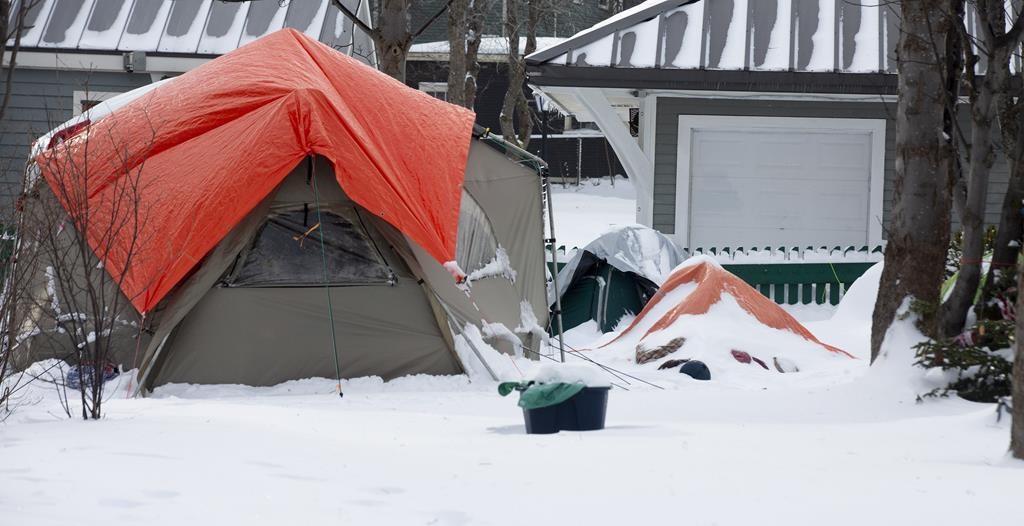Canada
Homeless N.L. man lives on $175 a month. Federal housing monitor says it’s not enough

ST. JOHN’S, N.L. — People on government income support programs are increasingly ending up in tents or homeless encampments, community workers said as they applauded Canada’s housing advocate’s recent call to boost minimum wages and social assistance rates.
Colin Young lives in an emergency shelter in St. John’s, where he gets $175 a month through the province’s income support program, in addition to meals, a bedroom and a roof over his head. He’s grateful for all of it, he said in a recent interview — it’s far better than sleeping in tents and a downtown parking garage, which he’d been doing since he was evicted from his last apartment in 2021.
But the money isn’t enough for the things he says will help him find a job and secure permanent housing, Young said.
With more money, he said, “I’d be able to get clean shoes, I’d be able to take care of myself, I’d be able to go out and actually get a job, look productive in society.
“How can you save up a damage deposit if you only get $87 every two weeks?” he added.
The country’s housing advocate, Marie-Josée Houle, monitors Canada’s progress upholding housing as a human right, which the federal government officially recognized in 2019. On Tuesday, she released a sweeping report about the spread of homeless encampments across the country, calling the situation a national life-and-death crisis of human rights.
The report made dozens of recommendations, including that provinces increase income supports and minimum wages to reflect the high cost of living and to “reinforce efforts to prevent homelessness and allow for successful transitions to adequate housing solutions.”
Lucas Groltz says increasing income support would make a tangible difference for people living in Halifax tent encampments. The co-ordinator of Downtown Halifax’s Navigator Outreach Program said many of his clients are homeless because they couldn’t afford rent hikes, often after renovictions — evictions under the pretext of renovations.Even rent at boarding houses, which he described as “cockroach motels,” has doubled in the past few years, Groltz said.
“They now find themselves unable to afford anything in the market. And they’re now living in tents, maybe they’re in a shelter, with no way to get back into the rental market,” he said in an interview. “It’s a very large mountain for them to climb right now. Any support there would benefit people greatly.”
One of Groltz’s clients, Bradley Lowe, was in the midst of a court battle over Nova Scotia’s income-support rates when he died at an encampment in December. Lowe was receiving $380 a month, the standard payment for someone without a home. He had argued he should be eligible for $950, the standard rate for people with disabilities who live in a household.
The majority of Canadian households on social assistance in 2022 had total annual incomes that put them in deep poverty, according to Maytree, an anti-poverty think tank based in Ontario.
Maytree’s Welfare in Canada 2022 report says annual incomes for single people considered employable on provincial income supports, including tax breaks and other benefits, ranged from $8,031 in New Brunswick to $20,905 in Quebec. In Newfoundland and Labrador, a single person considered employable earned $12,319.
The province increased its basic income support rate by five per cent in 2022, and last year introduced a basic income program that begins in April for residents aged 60-64. It also announced increased its tax benefits and income supplements for low-income residents, particularly those with children.
A spokesperson for the province’s Department of Children, Seniors and Social Development said there are supports in place for people receiving government aid who are seeking employment, including a $250 Job Start Allowance to assist with associated costs.
Jiaying Zhao, an associate professor of psychology at the University of British Columbia, said it’s a “no-brainer” for provinces to offer more money to its poorest and most vulnerable populations. It would likely curb homelessness and save taxpayer money, she said in a recent interview.
Zhao was involved in a project that gave 50 homeless people in B.C.’s Lower Mainland a one-time cash transfer of $7,500 — roughly the amount they would get in a year on welfare in the province — and then tracked them for 12 months. The study, published in Proceedings of the National Academy of Sciences last year, found recipients spent 99 fewer days homeless, and 55 more days in stable housing. They were also able to save more money.
The savings in shelter costs resulted in “societal cost savings” of $8,277 per recipient, the study said.
Zhao said it’s been “extremely” frustrating to watch government spend millions on hotels or new shelters for homeless people without increasing their incomes. Noting her study used a careful screening process — the team chose people who had been homeless for fewer than two years and who did not have significant mental health or addiction struggles — Zhao said provincial governments should consider not only raising income assistance rates, but offering a cash transfer using a similar selection process.
“This is a cost effective thing to do,” she said.
This report by The Canadian Press was first published Feb. 18, 2024.
Sarah Smellie, The Canadian Press
